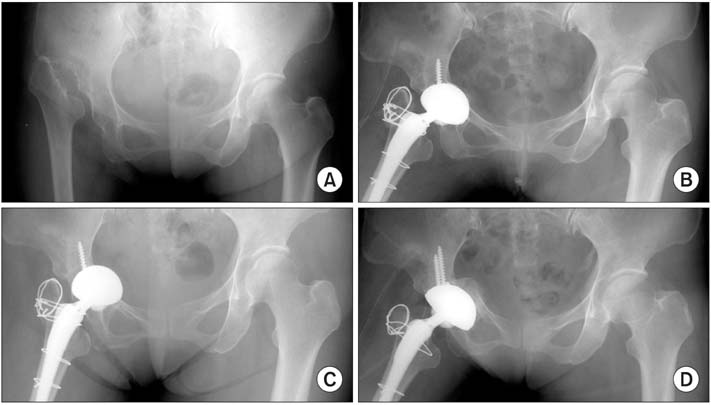Clin Orthop Surg.
2010 Sep;2(3):148-153. 10.4055/cios.2010.2.3.148.
Cotyloplasty in Cementless Total Hip Arthroplasty for an Insufficient Acetabulum
- Affiliations
-
- 1Department of Orthopaedic Surgery, Inchon Medical Center, Inchon, Korea.
- 2Department of Orthopaedic Surgery, Cheju National University College of Medicine, Cheju, Korea.
- 3Department of Orthopaedic Surgery, Seoul National University College of Medicine, Seoul, Korea. oskim@snu.ac.kr
- KMID: 999433
- DOI: http://doi.org/10.4055/cios.2010.2.3.148
Abstract
- BACKGROUND
Cotyloplasty is a technique that involves making a perforation of the medial wall of a shallow acetabulum and then inserting an acetabular cup with the medial aspect of its dome beyond the Kohler line. The purpose of this study was to evaluate the results of cementless total hip arthroplasty (THA) using cotyloplasty with focusing on the amount of medial cup protrusion.
METHODS
Sixteen hips with insufficient acetabulum in sixteen patients were treated by cementless THA using cotyloplasty. The average patient age was 47 years. The diagnoses included dysplastic hip (12) and infection sequelae (4). All the patients were followed up for at least 2 years. Clinically, the Harris hip scores were assessed and radiologically, the amount of cup protrusion, the hip center movement and cup fixation were evaluated.
RESULTS
The average Harris hip score improved from 57 to 94 postoperatively. The average proportion of cup surface beyond the Kohler line was 44.1% and the hip centers were medialized by an average of 23 mm. Stable fixation of the acetabular cup was achieved in all the cases except one. In this one case, migration of the cup was detected 2 weeks postoperatively and a reoperation was performed.
CONCLUSIONS
Using cotyloplasty, good coverage of the acetabular cup was obtained without a block bone graft, and the hip joint centers were medialized. However, the safety margin for the amount of protrusion should be established.
MeSH Terms
Figure
Reference
-
1. Charnley J, Feagin JA. Low-friction arthroplasty in congenital subluxation of the hip. Clin Orthop Relat Res. 1973. (91):98–113.
Article2. Dorr LD, Tawakkol S, Moorthy M, Long W, Wan Z. Medial protrusio technique for placement of a porous-coated, hemispherical acetabular component without cement in a total hip arthroplasty in patients who have acetabular dysplasia. J Bone Joint Surg Am. 1999. 81(1):83–92.3. Linde F, Jensen J, Pilgaard S. Charnley arthroplasty in osteoarthritis secondary to congenital dislocation or subluxation of the hip. Clin Orthop Relat Res. 1988. (227):164–171.4. Morsi E, Garbuz D, Gross AE. Total hip arthroplasty with shelf graft s using uncemented cups: a long-term follow-up study. J Arthroplasty. 1996. 11(1):81–85.5. Spangehl MJ, Berry DJ, Trousdale RT, Cabanela ME. Uncemented acetabular components with bulk femoral head autograft for acetabular reconstruction in developmental dysplasia of the hip: results at five to twelve years. J Bone Joint Surg Am. 2001. 83(10):1484–1489.
Article6. Silber DA, Engh CA. Cementless total hip arthroplasty with femoral head bone grafting for hip dysplasia. J Arthroplasty. 1990. 5(3):231–240.
Article7. Wolfgang GL. Femoral head autografting with total hip arthroplasty for lateral acetabular dysplasia: a 12-year experience. Clin Orthop Relat Res. 1990. (255):173–185.8. Gill TJ, Siebenrock K, Oberholzer R, Ganz R. Acetabular reconstruction in developmental dysplasia of the hip: results of the acetabular reinforcement ring with hook. J Arthroplasty. 1999. 14(2):131–137.9. Dunn HK, Hess WE. Total hip reconstruction in chronically dislocated hips. J Bone Joint Surg Am. 1976. 58(6):838–845.
Article10. Hartofilakidis G, Stamos K, Ioannidis TT. Low friction arthroplasty for old untreated congenital dislocation of the hip. J Bone Joint Surg Br. 1988. 70(2):182–186.
Article11. Hartofilakidis G, Stamos K, Karachalios T, Ioannidis TT, Zacharakis N. Congenital hip disease in adults: classification of acetabular deficiencies and operative treatment with acetabuloplasty combined with total hip arthroplasty. J Bone Joint Surg Am. 1996. 78(5):683–692.
Article12. Crowe JF, Mani VJ, Ranawat CS. Total hip replacement in congenital dislocation and dysplasia of the hip. J Bone Joint Surg Am. 1979. 61(1):15–23.
Article13. Lewinnek GE, Lewis JL, Tarr R, Compere CL, Zimmerman JR. Dislocations after total hip-replacement arthroplasties. J Bone Joint Surg Am. 1978. 60(2):217–220.
Article14. Harris WH. Traumatic arthritis of the hip after dislocation and acetabular fractures: treatment by mold arthroplasty: an end-result study using a new method of result evaluation. J Bone Joint Surg Am. 1969. 51(4):737–755.
Article15. Callaghan JJ, Heekin RD, Savory CG, Dysart SH, Hopkinson WJ. Evaluation of the learning curve associated with uncemented primary porous-coated anatomic total hip arthroplasty. Clin Orthop Relat Res. 1992. (282):132–144.
Article16. Engh CA, Griffin WL, Marx CL. Cementless acetabular components. J Bone Joint Surg Br. 1990. 72(1):53–59.
Article17. Joshi RP, Eftekhar NS, McMahon DJ, Nercessian OA. Osteolysis after Charnley primary low-friction arthroplasty: a comparison of two matched paired groups. J Bone Joint Surg Br. 1998. 80(4):585–590.18. Maloney WJ, Jasty M, Harris WH, Galante JO, Callaghan JJ. Endosteal erosion in association with stable uncemented femoral components. J Bone Joint Surg Am. 1990. 72(7):1025–1034.
Article19. Zhang H, Huang Y, Zhou YX, Zhou YX, Lv M, Jiang ZH. Acetabular medial wall displacement osteotomy in total hip arthroplasty: a technique to optimize the acetabular recon struc tion in acetabular dysplasia. J Arthroplasty. 2005. 20(5):562–567.
Article
- Full Text Links
- Actions
-
Cited
- CITED
-
- Close
- Share
- Similar articles
-
- Revision Arthroplasty with Cementless Total Hip Replacement
- Cementless Total Hip Arthroplasty in Long Term Steroid-Induced Avascular Necrosis of the Hip
- Implant Design in Cementless Hip Arthroplasty
- Medialization of Cementless Acetabular Components after the Removal of Subchondral Bone in Total Hip Arthroplasty
- Short Term Results of Cementless Total Hip Arthroplasty With a Tapered Femoral Component





